I played with the shots I had taken the day before, and at nine, Jools left to go tot he tip, visit Jen and so on, and it was just after she left I realised I could have gone to St Radegund's Abbey, but we would try to squeeze that in in on the afternoon.
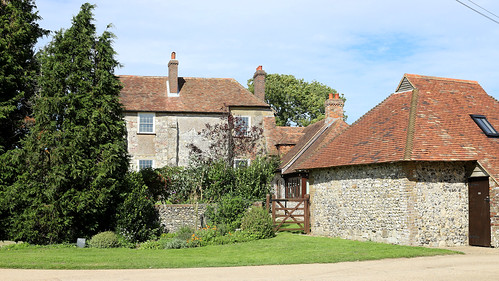 Instead, I go to scarify the lawn again, getting the simple mower looking thing, and push and pull it all over the lawn, ripping grass, moss and dead stuff out, then I go round to pick up the waste. I find again, I get the most grass out where the lawn is damp or wet, so next time there is rain, I will bout pushing and pulling again. This is because the Yellow Rattle and other wildflower mix does best on bare ground, and this will create lots of bare ground, meaning more wild flowers and grasses and less lawn.
Instead, I go to scarify the lawn again, getting the simple mower looking thing, and push and pull it all over the lawn, ripping grass, moss and dead stuff out, then I go round to pick up the waste. I find again, I get the most grass out where the lawn is damp or wet, so next time there is rain, I will bout pushing and pulling again. This is because the Yellow Rattle and other wildflower mix does best on bare ground, and this will create lots of bare ground, meaning more wild flowers and grasses and less lawn.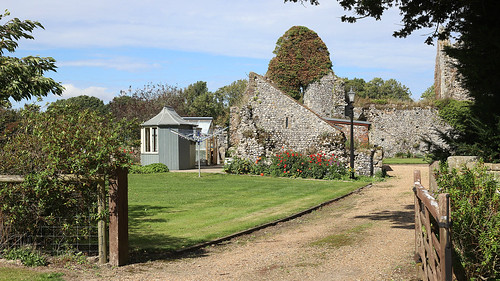 By half eleven I am done, I begin to prepare caprese for lunch, and try to resist the temptation of a glass or two of wine, as I need to drove in the afternoon.
By half eleven I am done, I begin to prepare caprese for lunch, and try to resist the temptation of a glass or two of wine, as I need to drove in the afternoon.The plan was to go to Ramsgate, Margate and if there was time, back to St Radegund's Abbey.
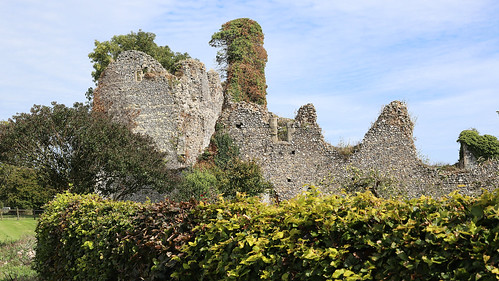 That was the plan.
That was the plan.I used to work in Ramsgate, and drove over to Thanet each working day, driving back early in the evening. Now, Ramsgate is not a bad place, like all it has good and bad, during the day the bad are usually out spending their giros on cheap beer from Wetherspoons or whatever. It has lots of interesting buildings, lots of history, and was a port with ferries going to France and Belgium until just a few years ago.
 St George sits on a high point in the middle of a maze of narrow side streets, not clogged with parked cars. I had taken notes, correctly that stated it was open on Thursday, Friday and Saturday. It is an impressive church, the tall tower topped by a lantern, but it looked closed. Some people were just leaving; how do you get in, I asked. You can't, its not open Sundays.
St George sits on a high point in the middle of a maze of narrow side streets, not clogged with parked cars. I had taken notes, correctly that stated it was open on Thursday, Friday and Saturday. It is an impressive church, the tall tower topped by a lantern, but it looked closed. Some people were just leaving; how do you get in, I asked. You can't, its not open Sundays.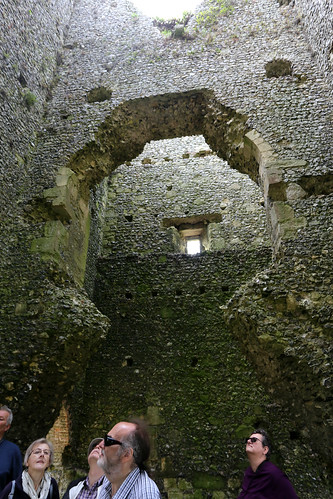 It was then I realised that my notes did not mention Sunday after all. D'oh, silly me.
It was then I realised that my notes did not mention Sunday after all. D'oh, silly me.So, instead of driving to Margate and then waiting for the church there to open at two, we drive back to Dover to the abbey.
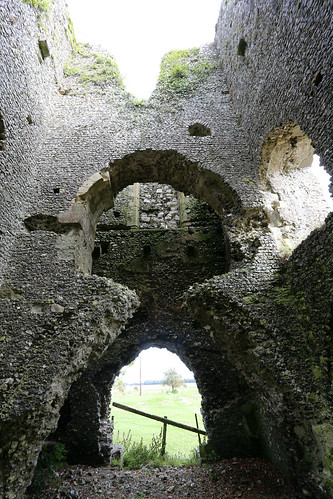 St Radegund's sits on a high plateau high above Dover, and is now very out of the way, part of the parish of Poulton, a parish that has not had a church for centuries. It was once one of the most important abbeys in England, visited by several kings, surrounded by two massive defensive ditches, but like all others, Henry VII ordered its destruction, and is now largely a ruin.
St Radegund's sits on a high plateau high above Dover, and is now very out of the way, part of the parish of Poulton, a parish that has not had a church for centuries. It was once one of the most important abbeys in England, visited by several kings, surrounded by two massive defensive ditches, but like all others, Henry VII ordered its destruction, and is now largely a ruin.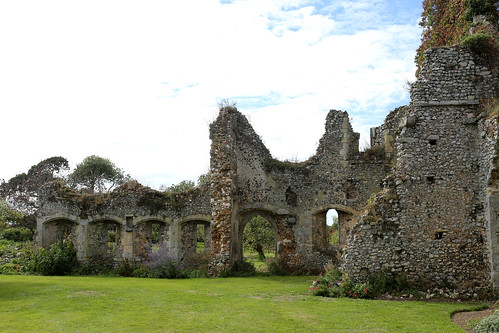 We had been past a couple of times, but it hadn't made much of an impression on me, and in Jools' words, is just a couple of walls.
We had been past a couple of times, but it hadn't made much of an impression on me, and in Jools' words, is just a couple of walls.In fact, it is so much more.
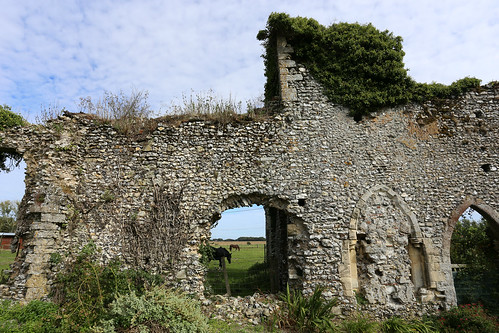 Since its dissolution, the ruins are now part of a working farm, and part of the structure is now the farm house, made with stones quarried nearly a thousand years ago. Amazing really.
Since its dissolution, the ruins are now part of a working farm, and part of the structure is now the farm house, made with stones quarried nearly a thousand years ago. Amazing really.Already, a number of people had gathered, so we parked in the farm, walked back round and waited.
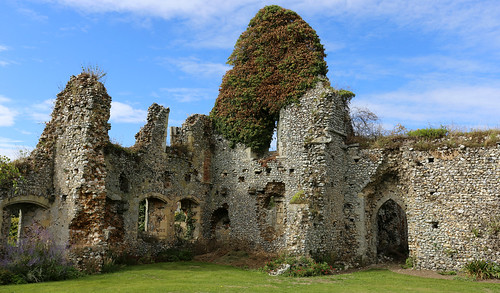 In time the owner, farmer, came to the five bar gate which blocked the way through under the part-ruined tower.
In time the owner, farmer, came to the five bar gate which blocked the way through under the part-ruined tower.Welcome he says, and from mostly memory, told the story of the abbey.
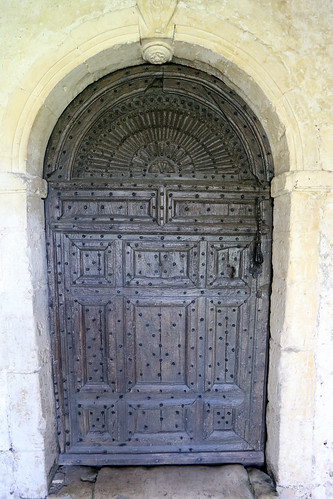 Then he walked us through the tower, making sure we did not linger as the state of the towers is very poor and flint blocks do fall from time to time. In fact the tower, which he said was the abbey church tower, is more like a castle keep than a church tower, and is two stories high still, most impressive.
Then he walked us through the tower, making sure we did not linger as the state of the towers is very poor and flint blocks do fall from time to time. In fact the tower, which he said was the abbey church tower, is more like a castle keep than a church tower, and is two stories high still, most impressive.He talked more as we went into the garden, which is surrounded on two other sides by ruined monastic buildings, and on the forth side is the farmhouse, repaired using material from other parts of the abbey in the 16th century, and very impressive for a family home.
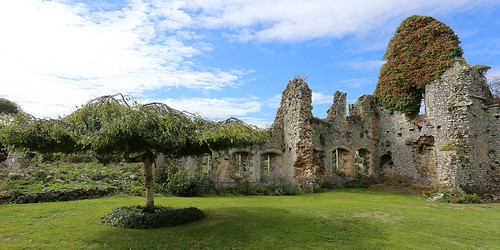 His wife came out I think to make sure the old boy didn't talk any squit, and followed us round as we admired their garden, and on the other side of the farmhouse, a rockery garden with a twenty feet high flint wall for plants to climb up.
His wife came out I think to make sure the old boy didn't talk any squit, and followed us round as we admired their garden, and on the other side of the farmhouse, a rockery garden with a twenty feet high flint wall for plants to climb up.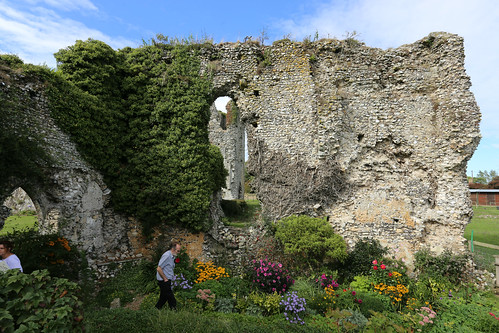 I asked about water, and we were shown the well, some 200 feet deep down to the water table, and back in the day, a harnessed oxen used to talk round and round, raising and lowering a bucket.
I asked about water, and we were shown the well, some 200 feet deep down to the water table, and back in the day, a harnessed oxen used to talk round and round, raising and lowering a bucket.Finally, there was a huge timber roofed barn, now a storage space, and with a new roof made from oak. All very impressive.
And that was it, time to go home for a brew. And an ice cream.
We sit in the garden, in the shelter, eating ice cream and sipping our brews. All looked good.
And somehow the weekend was slipping through our fingers, at least I don't have to go away this week, so no packing, booking seats or being in a general bad mood.
We watch a documentary on Egypt, but I am shouting at the TV as the BBC mke mistake after mistake, and is really a vehicle for showing some laser mapping devices. Still, good to look at it nothing else.
And that was it, time for bed, and work beckons in the morning.

No comments:
Post a Comment